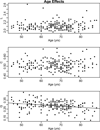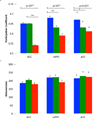Functional connectivity and graph theory in preclinical Alzheimer's disease
- PMID: 24216223
- PMCID: PMC3880636
- DOI: 10.1016/j.neurobiolaging.2013.10.081
Functional connectivity and graph theory in preclinical Alzheimer's disease
Abstract
Alzheimer's disease (AD) has a long preclinical phase in which amyloid and tau cerebral pathology accumulate without producing cognitive symptoms. Resting state functional connectivity magnetic resonance imaging has demonstrated that brain networks degrade during symptomatic AD. It is unclear to what extent these degradations exist before symptomatic onset. In this study, we investigated graph theory metrics of functional integration (path length), functional segregation (clustering coefficient), and functional distinctness (modularity) as a function of disease severity. Further, we assessed whether these graph metrics were affected in cognitively normal participants with cerebrospinal fluid evidence of preclinical AD. Clustering coefficient and modularity, but not path length, were reduced in AD. Cognitively normal participants who harbored AD biomarker pathology also showed reduced values in these graph measures, demonstrating brain changes similar to, but smaller than, symptomatic AD. Only modularity was significantly affected by age. We also demonstrate that AD has a particular effect on hub-like regions in the brain. We conclude that AD causes large-scale disconnection that is present before onset of symptoms.
Keywords: Alzheimer's disease; Biomarker; Functional connectivity; Graph theory; Resting-state.
Copyright © 2014 Elsevier Inc. All rights reserved.
Conflict of interest statement
Mr Brier, Mr Thomas, and Dr. Ances report no conflicts.
Figures






References
-
- Biswal B, Yetkin FZ, Haughton VM, Hyde JS. Functional connectivity in the motor cortex of resting human brain using echo-planar MRI. Magn Reson Med. 1995;34:537–541. - PubMed
Publication types
MeSH terms
Substances
Grants and funding
- K23MH081786/MH/NIMH NIH HHS/United States
- P01AG03991/AG/NIA NIH HHS/United States
- R01NR012907/NR/NINR NIH HHS/United States
- T32 GM007200/GM/NIGMS NIH HHS/United States
- R01 NR014449/NR/NINR NIH HHS/United States
- R01 NR012657/NR/NINR NIH HHS/United States
- 5T32GM007200-37/GM/NIGMS NIH HHS/United States
- P50 AG05681/AG/NIA NIH HHS/United States
- P01AG026276/AG/NIA NIH HHS/United States
- P01 AG003991/AG/NIA NIH HHS/United States
- R01NR012657/NR/NINR NIH HHS/United States
- P50 AG005681/AG/NIA NIH HHS/United States
- P01 AG026276/AG/NIA NIH HHS/United States
- R01NR14449/NR/NINR NIH HHS/United States
- R01 NR012907/NR/NINR NIH HHS/United States
- K23 MH081786/MH/NIMH NIH HHS/United States
LinkOut - more resources
Full Text Sources
Other Literature Sources
Medical
Molecular Biology Databases

